Taleni Etosha Village
September 3, 2012Namibia: Desert Homestead and Horse Trails
September 3, 2012Lappet-faced Vulture
Aegypius tracheliotus
Roberts No 124
by Pompie Burger
Since the Lappet-faced Vulture with its wingspan of over two metres is the largest of all Namibian vultures, you can understand why Peter Bridgeford and his co-workers are so concerned about its well-being. You will most probably come across some of these vultures when driving through the Namib Desert.
One of their favourite hangouts is the waterhole at Hotsas in the Namib-Naukluft Park, where, on a good day, you will see up to 30 or more hanging around, looking bored. This is one of the most exciting and nicest waterholes in the Namib-Naukluft Park, and it is worth spending time here. In addition to Lappet-faced Vultures, the chances are good that you will also see Cape fox and Namaqua Sandgrouse as a bonus. The Lappet-faced Vulture is usually one of the late arrivals at a carcass and is usually in the minority, while White-backed Vultures tend to be the most common ones there.
The admirable efforts to protect and preserve these fantastic, endangered birds are unfortunately countered by efforts of less clever people who poison them by putting out bait for unwelcome predators, in the process killing large numbers of these birds by secondary poisoning. (A Namibian farmer still holds the record for killing the most vultures during one such incident.) The fact that these vultures are an endangered species is unfortunately due to humans, indeed their only natural enemy. Interestingly they are immune to most diseases occurring in the wild.
Their diet consists mainly of the tendons, ligaments and skin of the carcasses they feed on. Very seldom do they eat the meat of the carcasses. They have also been seen eating stranded fish and even flamingo eggs and nestlings. Their nests are usually built on isolated flat-topped trees, the aesthetics of the nest leaving a lot to be desired. (If you see a picture of one of these nests with Dirk Heinrich’s face in the background, do not feel threatened, he is just one of Peter Bridgeford’s co-workers and not part of the nest.)
This article appeared in the Feb/March ‘10 edition of Travel News Namibia.
Based in Windhoek, Pompie Burger is an orthopaedic surgeon whose part-time passion is photography, in particular wildlife, and specifically birds. This regularly takes him to the most remote corners of the country, resulting in riveting images and articles.
Pompie is the author and photographer of the coffee table book Birds of Namibia, which was published in 2008. The book contains articles and photographs which attest to the insight and knowledge of an accomplished observer.
Read more of his articles in our Birding Section.

